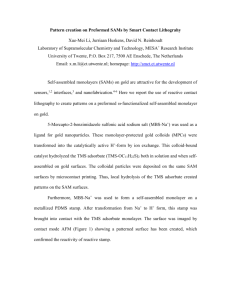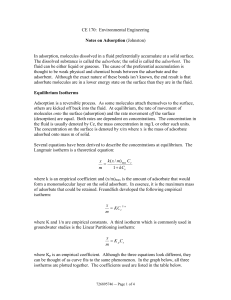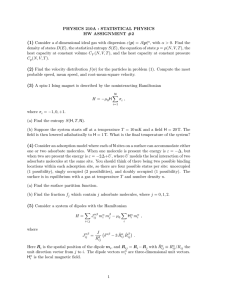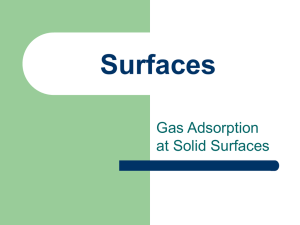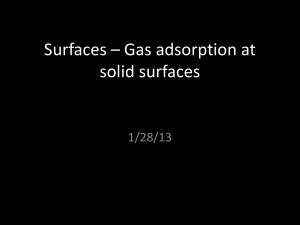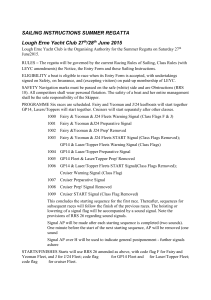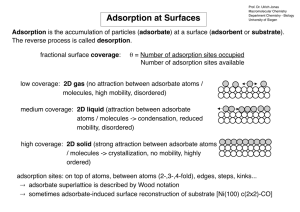Adsorbate migration effects on continuous and discontinuous temperature-dependent
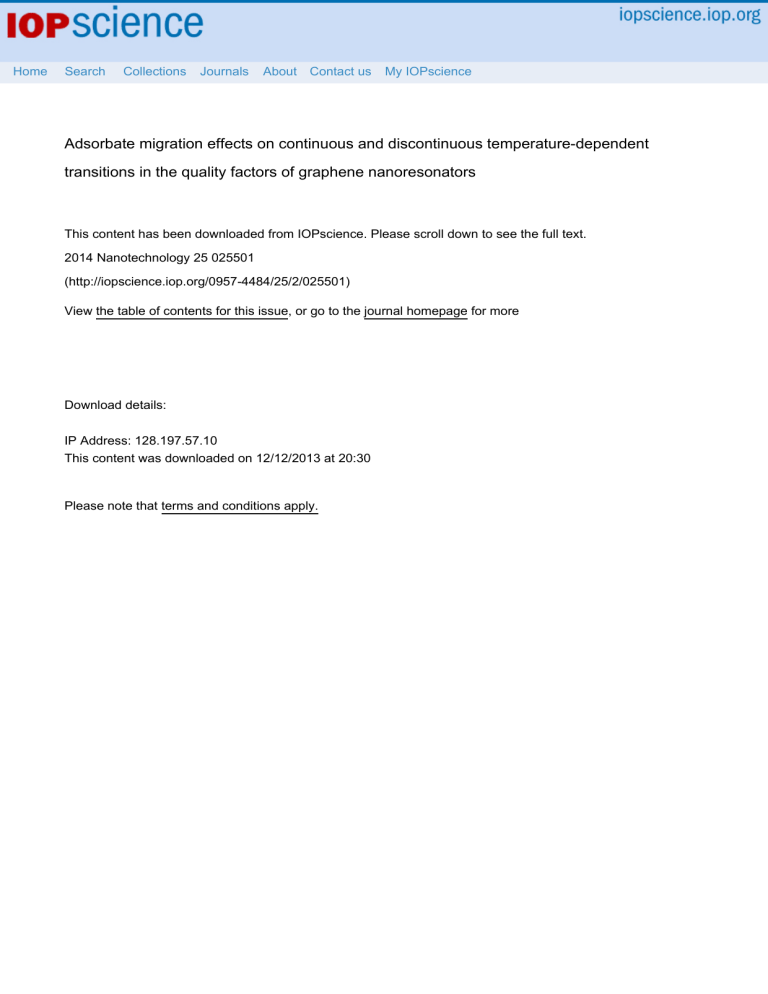
Home Search Collections Journals About Contact us My IOPscience
Adsorbate migration effects on continuous and discontinuous temperature-dependent transitions in the quality factors of graphene nanoresonators
This content has been downloaded from IOPscience. Please scroll down to see the full text.
2014 Nanotechnology 25 025501
(http://iopscience.iop.org/0957-4484/25/2/025501)
View the table of contents for this issue, or go to the journal homepage for more
Download details:
IP Address: 128.197.57.10
This content was downloaded on 12/12/2013 at 20:30
Please note that terms and conditions apply.
Nanotechnology doi:10.1088/0957-4484/25/2/025501 Nanotechnology 25 (2014) 025501 (8pp)
Adsorbate migration effects on continuous and discontinuous temperature-dependent transitions in the quality factors of graphene nanoresonators
Jin-Wu Jiang
, Bing-Shen Wang
, Harold S Park
and Timon Rabczuk
1
Shanghai Institute of Applied Mathematics and Mechanics, Shanghai Key Laboratory of Mechanics in
Energy Engineering, Shanghai University, Shanghai 200072, People’s Republic of China
2
Institute of Structural Mechanics, Bauhaus-University Weimar, Marienstraße 15, D-99423 Weimar,
Germany
3 State Key Laboratory of Semiconductor Superlattice and Microstructure and Institute of
Semiconductor, Chinese Academy of Sciences, Beijing 100083, People’s Republic of China
4 Department of Mechanical Engineering, Boston University, Boston, MA 02215, USA
5 School of Civil, Environmental and Architectural Engineering, Korea University, Seoul, Korea
E-mail: jwjiang5918@hotmail.com
, parkhs@bu.edu
and timon.rabczuk@uni-weimar.de
Received 19 August 2013, in final form 8 October 2013
Published 12 December 2013
Abstract
We perform classical molecular dynamics simulation to investigate the mechanisms underpinning the unresolved, experimentally observed temperature-dependent scaling transition in the quality factors of graphene nanomechanical resonators (GNMRs). Our simulations reveal that the mechanism underlying this temperature scaling phenomenon is the out-of-plane migration of adsorbates on GNMRs. Specifically, the migrating adsorbate undergoes frequent collisions with the GNMR, which strongly influences the resulting mechanical oscillation, and thus the quality factors. We also predict a discontinuous transition in the quality factor at a lower critical temperature, which results from the in-plane migration of the adsorbate. Overall, our work clearly demonstrates the strong effect of adsorbate migration on the quality factors of GNMRs.
Keywords: graphene nanoresonator, temperature scaling, adsorbate migration, energy dissipation
(Some figures may appear in colour only in the online journal)
1. Introduction
Graphene nanomechanical resonators (GNMRs) have drawn
intense attention [ 1 – 3 ] since the first experiments by Bunch
et al
in 2007 [ 4 ]. GNMRs are a promising candidate for
practical applications such as mass sensing due to their desirable combination of high stiffness and large surface
area [ 5 – 7 ]. For them to be effective for these applications,
it is imperative that the GNMRs exhibit a high quality
( Q ) factor. The Q -factor can be affected by various energy dissipation mechanisms, such as external attachment energy
result of both the theoretical studies and improvements in experimental studies of GNMRs, their reported Q -factors have increased considerably in recent years. For instance, Eichler et al
Q -factors of GNMRs can reach values of 10
5
. The temperature dependence of the Q -factor has also been studied in several experiments. Bunch et al
0957-4484/14/025501 + 08$33.00
1 c 2014 IOP Publishing Ltd Printed in the UK
Nanotechnology 25 (2014) 025501 observed a substantial increase in the Q -factor with decreasing temperature, with the Q
-factor reaching 9000 at 10 K [ 17 ].
Chen et al also found that the Q -factor of GNMRs increases with decreasing temperature, and reaches 10
4
A general characteristic in the temperature dependence of the Q -factor is the temperature scaling phenomenon; i.e., the
Q -factor increases exponentially with two different exponents above or below a critical temperature ( T z
). In other words, there is a continuous transition at T z in the temperature dependence of the Q -factor, where a clear experimental illustration of this temperature-dependent Q -factor transition can be found in figure 5 of the work by van der Zande et al
[ 17 ] and in figure 6 of the work by Chen
et al
The value of the transition temperature T z varies in different experiments, ranging from 50 to 100 K in the GNMRs
[ 17 , 18 ]. However, a theoretical explanation for this
phenomenon has not been presented. Furthermore, in all previous theoretical studies, only a single exponent was obtained for the temperature dependence of the Q -
factor in GNMRs or nanotube resonators [ 9 , 13 – 15 , 19 ].
Therefore, the aim of the present work is to identify the underlying mechanism for this unresolved temperature scaling phenomenon on the Q -factor of GNMRs.
In this paper, we identify the out-of-plane migration of adsorbate atoms as the cause of this unresolved temperature scaling phenomena on the Q -factors of GNMRs via classical molecular dynamics (MD) simulations. We identify two critical temperatures, the first being that at which the adsorbate starts to migrate in plane ( T xy
), and the second being that at which the adsorbate begins to migrate out of the plane of oscillation ( T z
). The Q -factor undergoes a discontinuous, step-like decrease at the first critical temperature T xy due to the introduction of strong thermal noise resulting from the in-plane migration. In contrast, a continuous transition in the
Q -factor is observed at the second critical temperature T z
, which corresponds to the temperature scaling phenomenon
observed in the experiments [ 17 , 18 ]. We also study the effects
of adsorbate percentage and mass on the temperature scaling phenomenon.
J-W Jiang et al ignored, and thus our simulation mimics a small adsorbate percentage. The standard Newton equations of motion are integrated in time using the velocity Verlet algorithm with a time step of 1 fs.
Our simulations are performed as follows. First, a
Nos´e–Hoover [ 22 , 23 ] thermostat is applied to thermalize the
system to a constant temperature within the NVT (i.e. the particle number N , the volume V and the temperature T of the system are constant) ensemble, which is run for 50 000
MD steps. (In this ensemble, the simulation box is not allowed to relax. Hence, the residual stress in the GNMR after fixing the two x ends will depend on the temperature. However, the residual stress is small due to the small length of the
GNMR.) The mechanical oscillation of the resonator is then actuated by adding a velocity distribution to the system, which follows the morphology of the first flexural vibrational
mode of graphene [ 14 ]. The imposed velocity distribution, or
actuation energy, is
1
E =
α
E
0 k
, where E
0 k is the total kinetic energy in the GNMR after thermalization but just before its actuation and
α is the actuation energy parameter. We have chosen a small value of
α
= 1
.
0 in all simulations here, so that the mechanical oscillation occurs within the linear regime.
After the actuation energy is applied, the system is allowed to oscillate freely within the NVE (i.e. the particle number N , the volume V and the energy E of the system are constant) ensemble for typically 10
6
MD steps. The data from the NVE ensemble are used to analyze the mechanical oscillation, energy dissipation, and Q -factors of the GNMR.
(We have ignored the randomness in the thermalization process; i.e., we perform only a single simulation for each temperature. This is because in the GNMR the flexural mode has been driven far from its thermal equilibrium state, whereas the other phonon modes are in thermal equilibrium.
This is because our actuation of the mechanical oscillation corresponds to the excitation of the fundamental flexural mode. In this situation, random effects on the flexural mode from its thermalization become negligible, as the density of states for the flexural mode is dominated by the actuation operation instead of the thermalization. As a result, the randomness can be safely ignored.)
2. Simulation details
3. Results and discussion
The smallest translational unit cell in graphene is chosen to contain four carbon atoms and has the size 2.46 ˚ × A.
l
The graphene sample in our simulations has dimensions
( l y x
, l y
= n
)
. The length is l x y
× 4
.
26 ˚ n x
= n and x n y
× 2
.
46 ˚ are the numbers of unit cells in the x and y directions. The atoms at the + x and − x ends of the GNMR are fixed, while periodic boundary conditions are applied in the y direction. The interactions of the carbon
atoms are described by the Brenner (REBO-II) potential [ 20 ].
For the cases where a single adsorbate atom is adsorbed on the GNMR, the interaction between the adsorbate gold atom and the GNMR is modeled by a Lennard-Jones potential with length parameter
σ
= 2
.
9943 ˚
= 0
.
029 36 eV [ 21 ], (where the cutoff distance for the
atom is considered, the interaction between adsorbates is
Figure
demonstrates that total energy is conserved in the
MD simulation within the NVE ensemble for a GNMR of size
(50, 6) with a single adsorbate, where the kinetic (potential) energy is above (below) the x axis. The potential energy is shifted by such a value that the total energy is zero, and the temperatures are 4.2 and 300 K in these two panels,
(where the temperature values in the present work are for the GNMR before actuation. Due to the energy applied to the GNMR to actuate its fundamental mode of vibration, and due to the oscillation of the GNMR within the NVE ensemble, the temperature in the GNMR does increase after actuation).
The mechanical oscillation is actuated at t = 0 by adding the velocity distribution, giving the maximum kinetic energy at t = 0. The mechanical oscillation of the GNMR is reflected by the energy exchange between the kinetic and potential energy.
2
Nanotechnology 25 (2014) 025501 J-W Jiang et al
Figure 1.
Energy conservation in the MD simulation for a GNMR of size (50, 6) with a single adsorbate. Kinetic (potential) energy is above (below) the x axis. The potential energy is shifted so that the total energy is zero.
(The decay of the oscillation amplitude for the kinetic energy is used to extract the Q -factor by fitting the kinetic energy from the NVE ensemble to a function E k
2
π/
Q
) t
( t
)
= a + b
(
1 − cos
(ω t
)
, where
ω is the frequency, a and b are two fitting parameters and Q is the resulting quality factor.) We note that the oscillation frequency is clearly higher at 300 K than at 4.2 K.
Figure
shows the temperature dependence for the frequency and the Q -factor in the GNMR of size (50, 6) with a single adsorbate, where both plots are presented in log–log scale. The top panel shows that the frequency has a clear power law temperature dependence, with power factor 0.23.
The frequency increases with increasing temperature, which results from the vibration-induced effective strain within
the GNMR [ 12 ]. The effective strain becomes stronger at
higher temperature, resulting in higher oscillation frequencies at higher temperature. (A different behavior was observed
experimentally [ 17 ]. The origin for this discrepancy between
simulations and experiments is still unclear.)
Figure
2 (b) shows two distinct transitions for the
temperature dependence of the inverse of the Q -factor. The first transition is discontinuous and occurs at the temperature
T xy
= 7 ± 1 K. The second transition is continuous and occurs at T z
= 47
.
5 ± 2
.
5 K. At the first transition temperature T xy
, we have determined from visualizing the simulation results that the adsorbate begins migrating within the plane of the GNMR.
During the in-plane migration, the adsorbate migrates on top
Figure 2.
The temperature dependence for the frequency and the
Q -factor in a GNMR of size (50, 6) with a single adsorbate. (a) The frequency has a clear power law temperature dependence, with power factor 0.23. (b) Two transition points in the temperature dependence of the inverse of the Q -factor. The first transition at
T xy
= 7 ± 1 K is discontinuous and is due to the in-plane migration of the adsorbate. The second transition at T z
= 47
.
5 ± 2
.
5 K is continuous and is caused by the out-of-plane migration of the adsorbate. The second transition corresponds to the temperature
scaling observed in experiments [ 17 , 18 ].
of the GNMR, but remains connected to the GNMR through the van der Waals interactions. A direct result of the in-plane migration is the excitation of many in-plane vibrational modes in the GNMR that result from the friction between the migrating adsorbate and the GNMR. As a result, the than is predicted by the MD simulations.
Q -factor of the GNMR is substantially reduced at T xy
. We note that the
Q -factor at T
<
7 K is so high (i.e. that energy dissipation is
quite weak, as has been observed experimentally [ 4 , 16 – 18 ])
that it is difficult for us to precisely extract its value from our
MD simulations. As a result, we assign the same Q -factor of 30 000 at these ultra-low temperatures, which is likely to be a lower bound estimate. (The upper limit for the Q -factor can be increased by extending the simulation time. The longest simulation time we have performed in this work is
30 ns for T = 6 K. According to this simulation time, the smallest increment in the frequency space is
1 f = 1
/
30 GHz.
The corresponding frequency in our simulation is about f =
1 THz, and so the upper limit for the Q factor can be estimated as Q upper
= f
/1 f = 30 000.) Hence, experimentalists should observe a larger decrease in the inverse of the Q -factor at T xy
3
Nanotechnology 25 (2014) 025501 J-W Jiang et al
Figure 3.
(a) The trajectory of the adsorbate where T
<
T xy shows a localized vibration of this adsorbate at 6 K. (b) In contrast, where
T
>
T xy there is a migration of the adsorbate at 8 K. The migration temperature is determined to be T xy
= 7 ± 1 K.
Figure 4.
The kinetic energy time history for a GNMR of size (50,
6) with a single adsorbate. The energy dissipation is obviously higher at 8 K than at 6 K, which demonstrates the strong dissipative effects that emerge from the in-plane adsorbate migration on the
Q -factor of the GNMR.
Figure
shows the xy trajectory of the adsorbate at temperatures 6 and 8 K, which are just below or above the first transition temperature T xy
= 7 K. Panel (a) shows that the motion of the adsorbate at 6 K is very localized. In contrast, panel (b) shows that at 8 K the adsorbate migrates around the surface of the GNMR. The kinetic energy time histories at these two temperatures are compared in figure
energy dissipation is obviously higher at 8 K than at 6 K, showing how the adsorbate migration strongly degrades the
Q -factors of GNMRs. These results provide clear evidence that the mechanism controlling the step-like jump in the
Q -factor in figure
at T xy adsorbate migration.
= 7 K is the initiation of the in-plane
At the second transition at of the Q -factor scales as
For T
>
T z
T
γ
, the inverse of the
T for T
<
T
Q z in figure z
with
γ
= 0
.
29.
-factor scales as T
β
, with
β
= 0
.
87. This transition is exactly the temperature scaling of the Q -factor which has been observed experimentally, where the corresponding scaling factors are
γ
= 0
.
35 and
β
= 2
.
3
in the experiment [ 17 ]. There are several possible effects that
may be responsible for this difference in the scaling exponents between our MD simulations and the experiments. (One likely factor is the adsorbate density. It can easily be rationalized that a higher adsorbate density should lead to larger value of
β
, as will be shown in the following. The difference between simulation results here and the corresponding experimental ones implies that there is a much higher adsorbate density in the experimental GNMR samples.)
We observe from visualizing the simulation results that the critical temperature T z is exactly the temperature at which the adsorbate begins to migrate out of the plane, i.e. in the z -direction. During this migration, the adsorbate develops sufficient kinetic energy such that it breaks the van der Waals bond connecting it to the GNMR, and travels away from the GNMR surface. Due to the finite size of the simulation box, the migrating adsorbate eventually reaches and reflects from the boundary of the simulation box, which results in it hitting the GNMR frequently from arbitrary directions.
These arbitrary collisions cause the excitation of various vibrational modes, including both in-plane and out-of-plane modes. If the incident angle of the adsorbate is orthogonal to the vibrational motion of the GNMR, then the out-of-plane modes will predominantly be excited, which strongly impacts the out-of-plane mechanical vibrations of the GNMR. As a result, the values in the MD simulations of
β are always larger than
γ
.
This point can also be understood from an energetic point of view. Figure
shows that substantially different potential energy barriers exist for adsorbate migration in the in-plane
( xy ) as compared to the out-of-plane ( z ) direction. Specifically, the energetic barrier is substantially smaller for the xy in-plane migration than the z -direction out-of-plane migration. This
4
Nanotechnology 25 (2014) 025501 J-W Jiang et al
Figure 5.
The potential energy barrier corresponding to the adsorbate migration in the xy (in-) plane (blue solid line) or z
(out-of-plane) direction (red dashed line). Inset: the xy migration direction.
is because the adsorbate will be attracted by neighboring carbon atoms during its migration process from one minimum potential energy position to a neighboring minimum potential energy position. As a result, the energy exchange between the adsorbate and the GNMR is larger for the z migration than the xy migration. In other words, the z migration has a stronger influence on the GNMR oscillation.
The second transition at T z is continuous, which is in
agreement with experiments [ 17 , 18 ]. It is different from the
step-like jump in the Q -factor at T xy because the migration of the adsorbate changes gradually from the in-plane migration into the out-of-plane migration.
To investigate the temperature scaling further, we calculate the mean migration distance (MMD) ( l mmd
) of the adsorbate, where the MMD is defined to be the average distance of the adsorbate per unit time. It is calculated from
Figure 6.
MMD of the adsorbate in a GNMR of size (50, 6) with a single adsorbate. (a) The MMD. (The two arrows indicate the two transition temperatures T xy and T z
.) The obvious transition at T z is with respect to the out-of-plane migration of the adsorbate. (b) The frequency of the collision between the adsorbate and the GNMR.
The linear temperature dependence at high temperature reflects the free motion of the adsorbate after the out-of-plane migration.
l mmd
= where N is the total number of MD simulation steps, E
( t
) is the trajectory of the adsorbate from the MD simulation, and
1 t is the time step in the MD simulation.
The MMD is shown in figure
proportional to
T to to
√ at T
T
47
.
5
,
200
.
0 ]
1
(
N − 1
)1 t
N − 1
X
|E
( t i + 1
) r
( t i
)
|
, i = 1
T
(1) in the whole temperature range except
K. For T
<
T z
, the MMD is proportional
. While no obvious transition is observed in the MMD xy
, an obvious transition occurs at T z
. Interestingly, in
√
T . These results are analyzed as follows. For T
<
T xy
, the
T . For temperatures T xy
<
T
T , the MMD is proportional to
<
T z
, the adsorbate migrates in the plane on top of the GNMR surface, and so the MMD is proportional to its xy velocities, which depend on temperature as T . Hence, the MMD within this temperature range also increases as T . At temperatures above T z
, the out-of-plane migration occurs, so the adsorbate moves freely without being attracted to the GNMR surface, and as a result the MMD is
T .
Some disturbance can be found in the MMD at T z in figure
6 (a), which indicates that the adsorbate has begun the
out-of-plane migration. In this stage, the adsorbate is trying to break the van der Waals bonds connecting it to the GNMR, but fails as the kinetic energy it gains from the GNMR is not sufficient to break the van der Waals bond.
Thus, in this temperature range, [47.5, 200.0] K, the adsorbate loses a substantial amount of its velocity whenever it attempts to escape, which accounts for the disturbance in the MMD seen at T z
. A specific example of this, i.e. an unsuccessful escape attempt at 50 K, is shown in figure
From top to bottom, the adsorbate attempts, but eventually fails, to escape and thus is pulled back towards the GNMR surface, as the kinetic energy it gains from the mechanical oscillation of the GNMR is not large enough to break its van der Waals bonds with the GNMR. Figure
distance between the adsorbate and the GNMR during this unsuccessful escape, which illustrates that the adsorbate is dragged back by the GNMR after the escape attempt. Panel
(b) shows the corresponding velocity of the adsorbate. During the whole unsuccessful escape attempt, the velocity of the adsorbate is generally lower than the value required by the
5
Nanotechnology 25 (2014) 025501 J-W Jiang et al
Figure 7.
An unsuccessful escape attempt of the adsorbate from the
GNMR at 50 K. From top to bottom, the adsorbate is trying to escape from the GNMR surface, but is unsuccessful because the energy imparted to it from the oscillation of the GNMR is not large enough to break the van der Waals bonds connecting it to the
GNMR. Velocity vectors are represented by arrows.
Figure 9.
A successful escape of the adsorbate from the GNMR at
300 K. From top to bottom, the adsorbate succeeds in escaping from the GNMR surface. Velocity vectors are represented by arrows.
sufficient kinetic energy to the adsorbate to allow it to escape from the GNMR surface. Figure
shows a successful escape for the adsorbate at 300 K. The kinetic energy passed to the adsorbate is large enough that the velocity of the adsorbate points in the outward direction with respect to the GNMR at the moment when the GNMR has zero velocity and maximum potential. Figure
shows the corresponding distance and the velocity of the adsorbate, which displays clearly the uniform motion of the adsorbate after breaking the van der Waals bond connecting it to the GNMR.
Figure
6 (b) shows the collision frequency between the
adsorbate and the GNMR. The collisions occur after the emergence of the out-of-plane migration for the adsorbate at temperatures above T z
. As previously discussed, the adsorbate eventually rebounds from the boundary of the simulation cell and thus collides frequently with the oscillating GNMR.
The collision frequency is calculated by the total collision counts divided by the total MD simulation time. In the high temperature range, the collision frequency increases linearly with increasing temperature, because both the free migrating
Figure 8.
The distance and velocity of the adsorbate during an unsuccessful escape attempt. (a) The nearest distance between the adsorbate and the GNMR. (b) The velocity of the adsorbate during the escape process.
equipartition theorem. As a result, this unsuccessful escape leads to the disturbance in the MMD seen in figure
With increasing temperature, more and more escape attempts become successful, because the GNMR can transfer
T . The combination of these two
T scaling relations gives the linear temperature dependence seen in figure
Figure
shows the frequency of the GNMRs with different sizes and doped by adsorbates with different mass
( m
Au
) or LJ energy parameter ( ). The length l x is important, as the frequency of the bending mode is proportional to 1
/ l
2 x
.
The other effects from different adsorbate mass or LJ energy parameter are not obvious as compared with the temperature effect in the figure. In all GNMRs, the frequency increases
6
Nanotechnology 25 (2014) 025501 J-W Jiang et al
Figure 11.
The frequency of the GNMR with different size and various adsorbate coverage conditions. The length ( L ) is important, as the frequency of the oscillation mode is proportional to 1
/
L
2 due to the flexural properties of the two-dimensional graphene sheet.
Figure 10.
The distance and velocity of the adsorbate during a successful escape. (a) The nearest distance between the adsorbate and the GNMR. (b) The velocity of the adsorbate during the escaping process.
with increasing temperature, following a power function with power factor 0.23, because of the vibration-induced effective
strain within the GNMR [ 12 ].
Finally, figure
shows how various effects impact the temperature scaling in the Q -factor of GNMRs. Panel (a) shows that changing the size of the GNMR only slightly modifies the value of the two transition temperatures
T z
T xy and
, as well as the two scaling factors
γ and
β
. Hence the size effect is not very important in the temperature scaling phenomenon of the Q -factor, so this phenomenon should be observed in GNMR samples of all sizes. (We note that this does not imply that the Q -factors of the GNMR are size independent. Indeed, the sizes of the GNMRs we have utilized in the present work are quite small, i.e.
l x
∈ [ 49
.
2
,
123 ]
˚ it is likely that this considered size-range is not sufficient to observe the well known decrease in Q -factor for NEMS with decreasing size.)
Panel (b) shows how increasing the number of adsorbates impacts the temperature scaling. For pure GNMRs without adsorbates, the Q -factor shows a linear temperature dependence. The power factor
γ is almost the same in both situations; while the power factor
β are 0.87 and 1.27 in
GNMR with one adsorbate (Au
1
) and two adsorbates (Au
2
), respectively. This significant change (46% difference in
β
) displays that the number of adsorbates has a substantial effect on the temperature scaling, where in particular the transition at
T z becomes sharper in GNMRs with more adsorbates. We note that this effect should be experimentally verifiable. (Another equivalent way to change the adsorbate density is to modify the simulation box size in the z direction. Because we could not obtain the adsorbate density value from the experiment, we have chosen the simulation box size (in the z -direction) as an appropriate value for MD simulations.)
Panel (c) shows that the strength of the van der Waals interaction between the adsorbate and the GNMR has an important effect on the value of the two critical temperatures
T xy and T z
. Specifically, these critical temperatures are reduced by nearly 50% if the interaction parameter between adsorbate and the GNMR is reduced by 50%, while
γ and
β are not obviously affected.
Finally, panel (d) shows that the mass of the adsorbate also plays an important role for the temperature scaling. For lighter adsorbates, the temperature scaling is smoother at
T z
. Both transition temperatures T xy and T z become much higher for the lighter adsorbate, since those atoms have a smaller kinetic energy at the same temperature as larger mass adsorbates, and therefore more thermal energy is needed to induce migration for the smaller mass atoms. Panels (c) and (d) may serve as useful guidelines for experimentalists to verify our theoretical predictions, as different types of adsorbate (of different masses or/and different interaction strengths with GNMRs) are usually observed experimentally.
4. Conclusion
In conclusion, we have performed classical MD simulations to study how adsorbate migration affects the Q -factors of GNMRs. Our key finding is that there are two critical temperatures, which correspond to the initiation of in-plane and out-of-plane migration of the adsorbate.
The out-of-plane adsorbate migration is found to be the origin for the temperature scaling in the Q -factor observed
experimentally [ 17 , 18 ], because the resonant oscillation of
7
Nanotechnology 25 (2014) 025501 J-W Jiang et al
Figure 12.
Various effects on the temperature scaling in the inverse of the Q -factor. (a) Similar temperature scaling in GNMRs of different dimensions when a single adsorbate is considered. (b) The temperature scaling in GNMRs with different numbers of adsorbates. (c) The temperature scaling for GNMRs with different interaction strength between the adsorbate and the GNMR.
= 1 corresponds to the actual
LJ energy parameter (0.029 36 eV) between Au and C. (d) The temperature scaling in the case of different adsorbate masses.
the GNMR is strongly interrupted by collisions from the migrating adsorbate. We predict a discontinuous decrease of the Q -factor at the lower critical temperature due to the initiation of in-plane migration of the adsorbate. We also studied, in the hopes of providing useful guidelines to experimentalists to verify these theoretical predictions, how different numbers of adsorbate atoms, sizes of the GNMR, or strengths of van der Waals interactions between the adsorbate and the GNMR impact the temperature scaling of the
Q -factor.
Acknowledgments
JWJ would like to point out that the idea of the out-of-plane migration was stimulated by a game with his first baby CC, who is crazy about putting everything on top of the bed sheet and vibrating the sheet to throw things into the air. The work is supported by the German Research Foundation (DFG).
HSP acknowledges the support of NSF-CMMI 1036460. All authors thank Andreas Isacsson for valuable discussions in the initial stage of the work.
References
[1] Ekinci K L and Roukes M L 2005 Rev. Sci. Instrum.
76 061101
[2] Arlett J, Myers E and Roukes M 2011 Nature Nanotechnol.
6 203
[3] Eom K, Park H S, Yoon D S and Kwon T 2011 Phys. Rep.
503 115
[4] Bunch J S, van der Zande A M, Verbridge S S, Frank I W,
Tanenbaum D M, Parpia J M, Craighead H G and
McEuen P L 2007 Science 315 490
[5] Lee C, Wei X, Kysar J W and Hone J 2008 Science 321 385
[6] Jiang J-W, Wang J-S and Li B 2009 Phys. Rev.
B 80 113405
[7] Jiang J-W, Wang J-S and Li B 2010 Phys. Rev.
B 81 073405
[8] Seo´anez C, Guinea F and Neto A H C 2007 Phys. Rev.
B
76 125427
[9] Kim S Y and Park H S 2009 Appl. Phys. Lett.
94 101918
[10] Atalaya J, Isacsson A and Kinaret J M 2008 Nano Lett.
8 4196
[11] Kunal K and Aluru N R 2013 J. Appl. Phys.
114 084302
[12] Jiang J-W, Park H S and Rabczuk T 2012 Nanotechnology
23 475501
[13] Kim S Y and Park H S 2009 Nano Lett.
9 969
[14] Jiang J-W and Wang J-S 2012 J. Appl. Phys.
111 054314
[15] Qi Z and Park H S 2012 Nanoscale 4 3460
[16] Eichler A, Moser J, Chaste J, Zdrojek M, Wilson-Rae I and
Bachtold A 2011 Nature Nanotechnol.
6 339
[17] van der Zande A M, Barton R A, Alden J S, Ruiz-Vargas C S,
Whitney W S, Pham P H Q, Park J, Parpia J M,
Craighead H G and McEuen P L 2010 Nano Lett.
10 4869
[18] Chen C, Rosenblatt S, Bolotin K I, Kalb W, Kim P,
Kymissis I, Stormer H L, Heinz T F and Hone J 2009
Nature Nanotechnol.
4 861
[19] Jiang H, Yu M-F, Liu B and Huang Y 2004 Phys. Rev. Lett.
93 185501
[20] Brenner D W, Shenderova O A, Harrison J A, Stuart S J, Ni B and Sinnott S B 2002 J. Phys.: Condens. Matter 14 783
[21] Kim S Y and Park H S 2010 Nanotechnology 21 105710
[22] Nose S 1984 J. Chem. Phys.
81 511
[23] Hoover W G 1985 Phys. Rev.
A 31 1695
8
